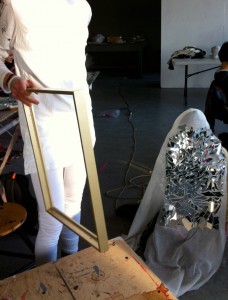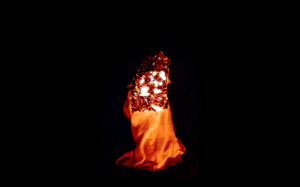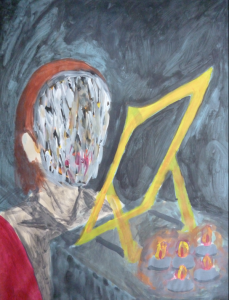In Mark 9, notice that the Lord Jesus repeats three times about Hell, “where the worm dieth not and the fire is not quenched.”
A source of inspiration: Virginia Woolf (1882 -1941).
A writer very much concerned with the transformation of life through art, sexual ambivalence and the flux of time and life (in the form of corrosion and rejuvenation). Her style of writing is experimental and somewhat playful; time and gender for example are sometimes shifted in unexpected ways. She dealt with the problems some people of her time were having with the world around; most of which people today can still relate to.
She suffered from severe bouts of mental illness throughout her life and eventually committed suicide by drowning at the age of 59.
It is all about the design of a headpiece.
First, it is always about trying to get a grip on the thing, trying to get under the skin of the object of investigation. It is the same way of working for writers in general as for me trying to crawl under the skin of a writer in order to create a kind of mask.
What does it mean to be a writer?

appropriate dressing for the process
The writer is holding up the mirror to the world, and says to herself: “Look! the world is so full of life! Think of all the passions that exist there (love, hate, anger, etc.). It is a fire that cannot be quenched.” She is sitting behind her desk in her writing shack, reflecting on the world outside – creating parallel universes. The passions of this world are powerful things, and those are the things she needs to deal with. The writer shall not remain untouched for long. The writer desperately holds up to the mirror.
Writing is a way to deal with the fire, a way of protecting oneself. The writings also make the world more aware of itself – of what it does. The message is perhaps not always pleasant, but always necessary. The world as it is is not by definition how it is supposed to be. The world (and its fire burning within) needs to look into its reflection every now and then. But the fire is aggressive and with time the mirror corrodes and begins to show signs of breaking. The first shards fall of the mirror and pierce the skin of the writer. It hurts, but the writing continues. What else can the writer do? At a certain point the frame of the mirror is empty and the entire mirror has become part of the face: A MASK OF BROKEN MIRROR. The mirror has become part of the writer. Now it is the writer herself that is reflecting the world. The writer is not of our world anymore; she has become a kind of prophet.
“[…] and he was transfigured before them. And his raiment became shining, exceeding white as snow; so as no fuller on earth can white them.” (Mark 9)
painting of the first 'vision' I had of the mask I was going to make
THIS IS A WRITERS MASK. Virginia Woolf as the source of inspiration provided direction for the choice of form and color.
The fabric of the writers mask is white. White as the color of the prophet and as the color of cleansing and purity, which are the intended aims of the process of writing and reading. Technically white would also be the color that reflects the light most strongly, creating a strong contrast with what happens in the mirroring surface (which is mostly darkness, except for the fire).
It is woven textile that creates a strong association with the Victorian era, during which Virginia Woolf was born. Also, the fabric is frayed at the ends and on the sides because it is a long process to become a writer (time withers the textile).
A rectangular shaped surface filled with the luminous shards of the broken mirror is covering the face and extending downwards across the chest. The rectangular shape of the covering broken mirror suggests the mirror when it was still framed.
The mask is put on more or less like a kerchief: (1) first the mirror part is put in front of the face, (2) then the scarf-like extension goes over the head, (3) and under the chin and/or over the face, and (4) then finally back over the head to fixate the mirror part. The fabric is long enough so that it covers the whole body by (5) drawing it two or three times around the neck and head.
The essential thing about the mask is the refection of fire in the mirror-pieces. The fire symbolizes the passions of life, or the Hell, of the world around. This fire has an immaterial quality, and this is important. Emotions and passions and other things that concern writers are often things that exist beyond our material reality. Many many words and/or a good deal of symbolism are needed to make them sensible. The light and the aggressive nature of fire would be a good way to illustrate those immaterial forces.
So in its completeness THE MASK IS REFLECTING THE FIRE.
But even though the fire is essential, ultimately, the fire is only a metaphor for the burning fire of life itself, and we can say that this fire of life originates from the sun and is sustained by the sun. Therefore the sun is the perfect fire to illuminate all that is reflected in the mask.
Behind the mask is a living being. It moves. It is communicating, but the language is of another world. The intensity of the fire seems to change all the time. We hear the fire burning. We see the flashing reflections in the mirror. In fact we can see ourselves, fragmented, through the mirror, in the fire. Fire is burning away all the time, consuming the life that is inside, but the fire cannot be quenched.






